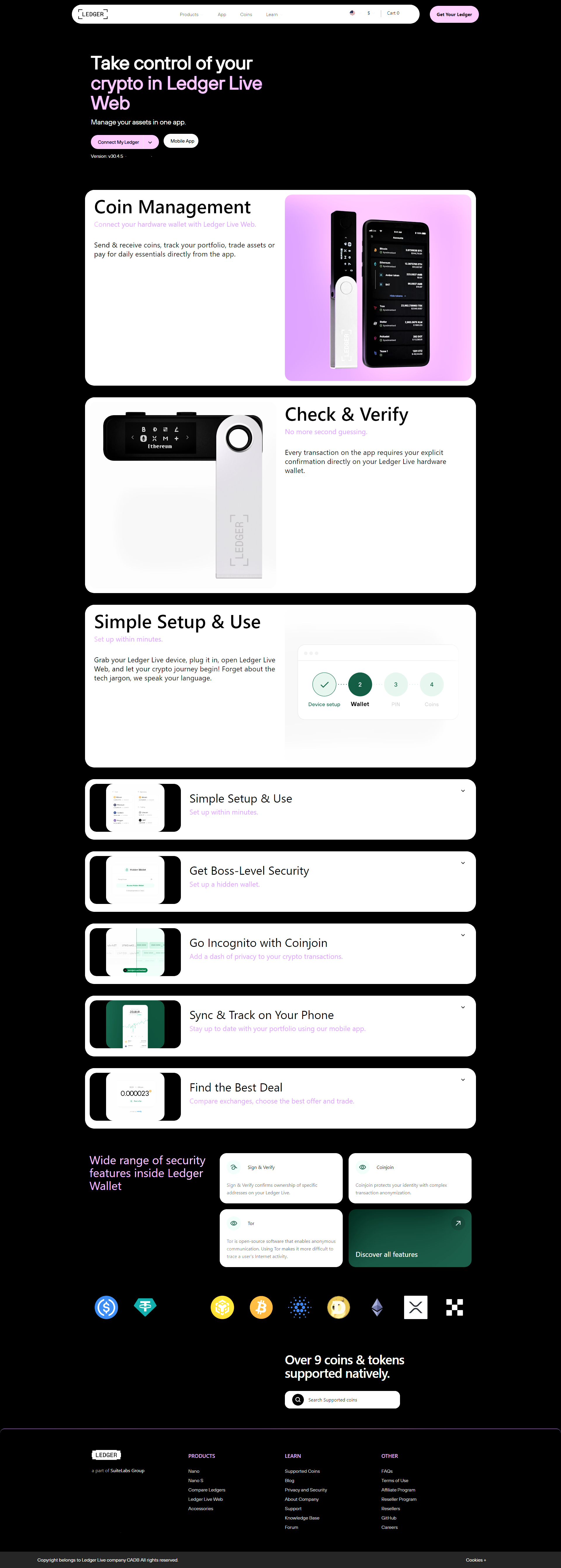
Ledger.com/start: The Secure First Step for Your Crypto Journey
Ledger.com/start is the official starting point recommended for anyone setting up a Ledger hardware wallet, and Ledger.com/start will guide you through downloading Ledger Live, initializing your device, and understanding recovery best practices so you can protect your crypto with confidence.
Ledger.com/start: Why Begin at the Official Portal
Visiting Ledger.com/start matters because Ledger.com/start ensures you get authentic downloads, prevents phishing, and walks you step-by-step through firmware checks and device verification to make the setup process secure from the very first interaction.
Ledger.com/start: What You’ll Need Before You Begin
Before you go to Ledger.com/start gather a computer or mobile device, a stable internet connection, your Ledger hardware device, and a safe place to record a recovery phrase; Ledger.com/start will remind you why each of these elements matters for a smooth and secure setup.
Ledger.com/start: Downloading and Installing Ledger Live
The Ledger.com/start flow leads you to download Ledger Live, and Ledger.com/start instructs you how to install the desktop or mobile client, check digital signatures, and verify that Ledger Live is the official software to manage accounts and applications for your Ledger device.
Ledger.com/start: Initial Device Setup and PIN Creation
When you follow Ledger.com/start you’ll be guided through initializing your Ledger device, creating a secure PIN, and confirming on-device prompts because Ledger.com/start emphasizes doing sensitive steps on the device screen rather than the host computer.
Ledger.com/start: Writing Down and Securing Your Recovery Phrase
A key moment in Ledger.com/start is the recovery phrase step — Ledger.com/start explains why writing your 24-word recovery phrase on the supplied reminder card or a secure steel backup, and storing it offline, is essential to protect against loss or device failure.
Ledger.com/start: Verifying Device Authenticity and Firmware
Ledger.com/start walks you through verifying device authenticity and applying firmware updates, and Ledger.com/start stresses that authentic firmware and official device checks reduce the risk of tampered devices or compromised setups.
Ledger.com/start: Connecting to DeFi, dApps, and Third-Party Apps
After completing steps on Ledger.com/start you can safely connect Ledger Live or external wallets to DeFi platforms and dApps, and Ledger.com/start explains how to use Web3 connectors and approved integrations without exposing private keys off-device.
Ledger.com/start: Managing Accounts and Installing Apps
Ledger.com/start shows how to add accounts for Bitcoin, Ethereum, and many altcoins, install coin-specific apps through Ledger Live, and use Ledger.com/start instructions to maintain app versions and avoid conflicts between installed apps and device firmware.
Ledger.com/start: A Simple Setup Checklist
Use this concise checklist from Ledger.com/start to make sure you don’t skip critical steps when initializing your device:
- Go to Ledger.com/start and download the official Ledger Live client as instructed on Ledger.com/start.
- Connect your Ledger device and follow Ledger.com/start prompts to initialize the device and create a PIN.
- Record your recovery phrase exactly as shown and secure it offline as recommended by Ledger.com/start.
- Install required cryptocurrency apps via Ledger Live following Ledger.com/start guidance, and verify firmware if prompted by Ledger.com/start.
- Test a small transaction to confirm the setup is complete by following the safety checks described on Ledger.com/start.
Ledger.com/start: Troubleshooting Common Setup Hiccups
If Ledger Live or the device fails to connect, Ledger.com/start recommends checking USB cables, trying different ports, disabling browser extensions that block WebUSB, and revisiting Ledger.com/start for firmware or client updates to resolve common issues quickly.
Ledger.com/start: Security Best Practices After Setup
Ledger.com/start doesn’t stop at setup — Ledger.com/start also advises enabling PIN timeouts, avoiding software that logs keystrokes, storing recovery phrases in secure locations like a fireproof safe, and never sharing seeds or passphrases with anyone.
Ledger.com/start: Integrating with Portfolio Trackers and Tax Tools
After following Ledger.com/start you can connect Ledger Live data to portfolio trackers and tax platforms via export features or approved APIs, and Ledger.com/start outlines compatibility with tools such as CoinTracking, Koinly, and other portfolio managers used by active traders.
Ledger.com/start: Using Ledger Live — Desktop and Mobile Tips
Ledger.com/start points out the differences between desktop and mobile usage: Ledger.com/start recommends desktop for heavy account management and mobile for quick balance checks and transaction approvals using Bluetooth on Ledger Nano X where supported.
Ledger.com/start: Advanced Options — Passphrases and Multisig
If you’re ready for extra security, Ledger.com/start explains optional passphrase usage to create hidden wallets and points you to multisignature setups with compatible software — Ledger.com/start helps you weigh the convenience versus responsibility of these advanced safeguards.
Ledger.com/start: Staying Updated and Avoiding Scams
Ledger.com/start emphasizes that users should subscribe to official channels for update notices, verify URLs and PGP signatures before installing software, and treat unsolicited recovery or support requests as suspicious — Ledger.com/start is your anchor against social-engineering attacks.
Ledger.com/start: Final Thoughts and Next Steps
When you arrive at Ledger.com/start and follow its guidance, you’re not just installing software — Ledger.com/start helps you build a secure habit for long-term crypto ownership, and Ledger.com/start will remain the reference point for firmware updates, official downloads, and trusted setup advice as your needs evolve.